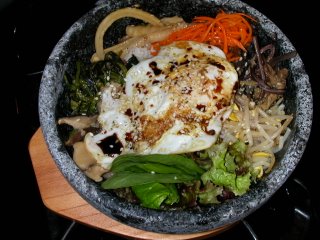During Chris’ April 2007 trip to Korea, he discovered Korea’s national dish: Bibimbap. More specifically, he discovered dolsot bibimbap. Words can’t do it justice, but to point you in the right direction, Bibimbap is a bowl of warm rice usually topped with sautéed veggies, gochujang* chili pepper paste, an egg, and thinly sliced meat (usually beef). The dolsot part refers to the hot, stone bowl or pot in which it is served. The stone bowl is so hot that it actually continues to cook the rice so it’s crisp when you get to the bottom. Mmmm…

Chris fell so in love with the dish that he carried home two stone bowls. When I picked up the bowls, I knew he was serious about this new dish. They’re heavy!
Our first attempt to purchase the ingredients for dolsot bibimbap included many of the struggles of grocery shopping in another land. So many of the sauces in the Korean market we visited were in…well, Korean…that we had to ask for help finding the sauce. We couldn’t figure out how to pronounce “gochujang”, so we pointed to it on our list of ingredients. If our eyes had trouble with the Korean version, no doubt the Korean we asked felt the same about our English. Eventually he found someone who spoke enough English to decipher our request and point us to the sauce.
*Gochujang is a fermented soybean paste seasoned with Korean chilies, rice powder and honey. It’s hot, sweet, salty, savory and sour. What could be better! It was love at first taste.
Last weekend, we drove to Annandale to try bibimbap at one of the many Korean restaurants in our new city. Part of our excursion was to also find more stone bowls. We want to expand our dolsot (stone bowl) collection so we can share this dish with our family and friends. We asked our waitress where we might be able to find the bowls. There was much discussion between members of the staff and a neighboring table that we couldn’t understand. And then there was discussion with us that we didn’t understand. In the end, our waitress explained that when we were finished eating, someone would give us the address to a place where we would find many to choose from.
Just as we finished our last bites, the entire staff sat down at a large table and began to eat. It was like a family sitting down to dinner. We hesitated to act like we were done, because we didn’t want to disturb them, but our waitress noticed and brought us the bill. When we had paid she said, “She will show you the way to the place” and pointed to the a woman who had been involved in our bibimbap bowl discussion.
“But she’s eating.” Chris protested.
“I don’t know, maybe she needs to buy something there.” Our waitress assured in broken English.
She lead us to the Seoul Department Store, walked us in, pointed out the bowls, offered her opinion on what was good, and translated the salesman’s tips on caring for the stone. We thanked her, and she disappeared.
She didn’t need to buy anything there. She was just being kind.

